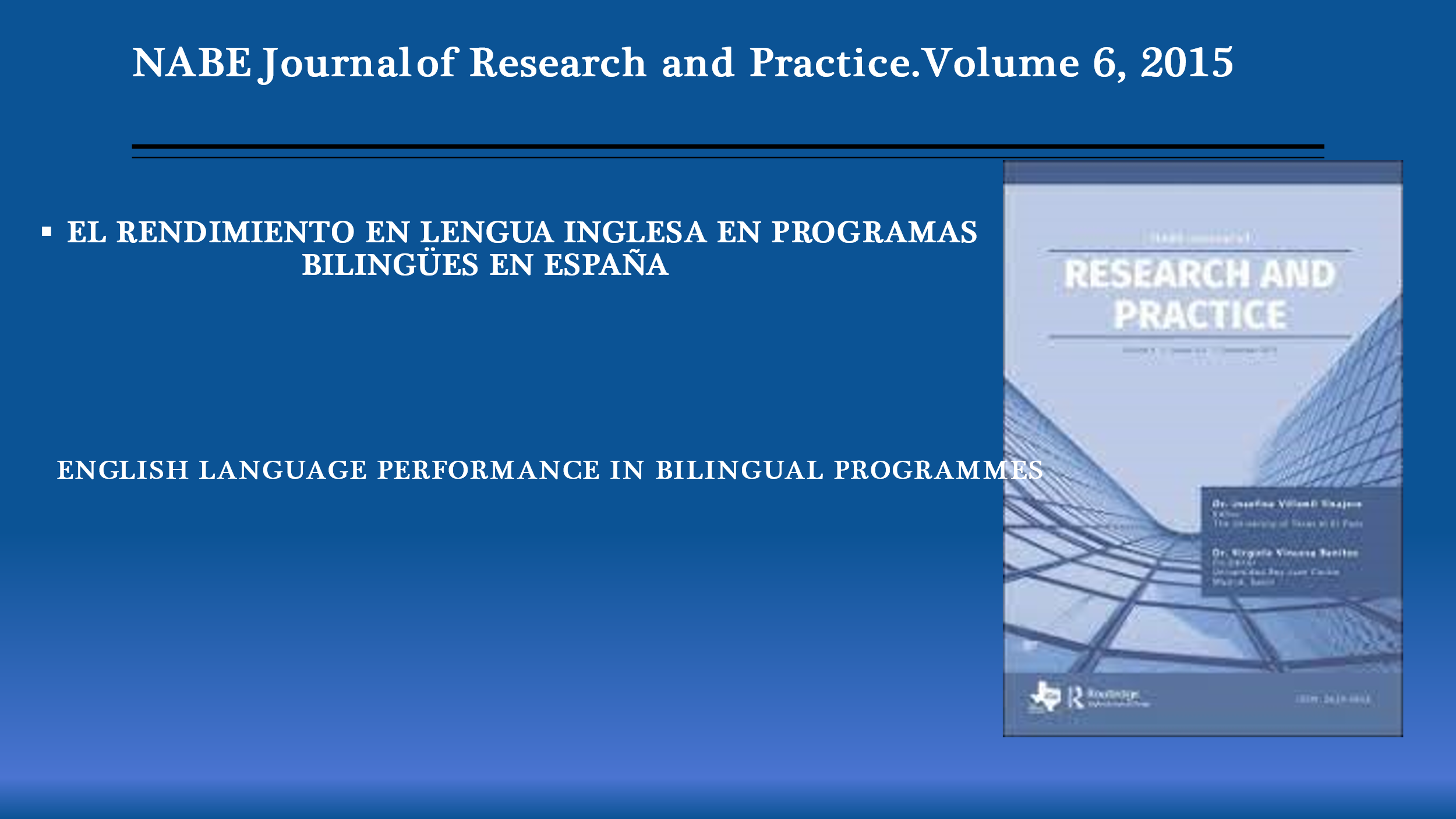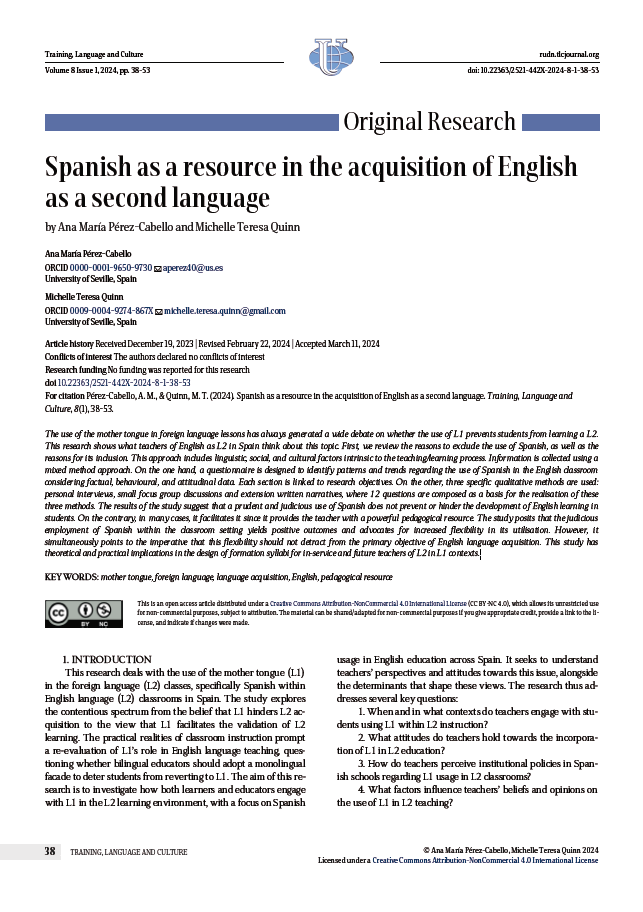Spanish as a resource in the acquisition of English as a second language
Madrid, marzo de 2024
|
|
The use of the mother tongue in foreign language lessons has always generated a wide debate on whether the use of L1 prevents students from learning a L2. This research shows what teachers of English as L2 in Spain think about this topic. First, we review the reasons to exclude the use of Spanish, as well as the reasons for its inclusion. This approach includes linguistic, social, and cultural factors intrinsic to the teaching/learning process. Information is collected using a mixed method approach. On the one hand, a questionnaire is designed to identify patterns and trends regarding the use of Spanish in the English classroom considering factual, behavioural, and attitudinal data. Each section is linked to research objectives. On the other, three specific qualitative methods are used: personal interviews, small focus group discussions and extension written narratives, where 12 questions are composed as a basis for the realisation of these three methods. The results of the study suggest that a prudent and judicious use of Spanish does not prevent or hinder the development of English learning in students. On the contrary, in many cases, it facilitates it since it provides the teacher with a powerful pedagogical resource. The study posits that the judicious employment of Spanish within the classroom setting yields positive outcomes and advocates for increased flexibility in its utilisation. However, it simultaneously points to the imperative that this flexibility should not detract from the primary objective of English language acquisition. This study has theoretical and practical implications in the design of formation syllabi for in-service and future teachers of L2 in L1 contexts.
|

El Rendimiento en Lengua Inglesa en Programas Bilingües en España
Madrid, noviembre de 2023
|
La comparación de los resultados de rendimiento en Lengua Inglesa –evaluado mediante pruebas externas– de los estudiantes que forman parte de los programas bilingües de enseñanza de la Comunidad de Madrid pone de manifiesto que el rendimiento académico en inglés al final de la Educación Primaria de los alumnos escolarizados en centros bilingües con el modelo propio de la Comunidad de Madrid (CM) es significativamente superior al de los estudiantes que están escolarizados con el modelo del convenio entre el Ministerio de Educación y el British Council (MEC-BC). Esta competencia en Lengua Inglesa es mejor, como promedio, en los centros del modelo propio de la Comunidad de Madrid, a pesar de que los alumnos inicien su aprendizaje de inglés a los 6 años, en contraposición con el promedio de rendimiento en Lengua Inglesa en los centros del modelo MEC-BC, que lo inician en la Educación Infantil, a los 3 años. |
|
 |
|

ALGUNAS REFERENCIAS SOBRE ENSEÑANZA BILINGÜE
|
|
|
|
|
|
|
|
|
|
|
|
|
|
|
|
|
|
|
|
|
|
|
|
|
|
|
|
|
|
|
|
|
|
|
|
|
|
Assessment re-visited
Marta Genis, Ph.D.
Trinity College London Spain
Assessment, in Education, refers to the knowledge needed for gathering data about the students’ learning and using that information to improve teaching and, ultimately, the outcomes of students. According to Stiggins (2008, p.2)1, assessment practices that were before used “to separate the successful from the unsuccessful student now must become practices that support the learning of all students”. Therefore, assessment is now regarded as the other face of the coin of instruction, a tool that helps teachers plan and readjust teaching and learning programmes so that both teachers and students can improve the process of education, thus satisfying the primary purpose of assessment: to improve students’ learning and teachers’ teaching, producing a permanent flow of information in order to fine-tune the learning goals for the students’ success. Harris & Mc Cann (1994, p.2)2 consider assessment as “one of the most valuable sources of information about what is happening in a learning environment.”
Why Are Some Teachers Lacking Confidence When Teaching Primary Spelling, Punctuation And Grammar
"I can’t remember being taught much grammar until I took a course in ‘Use of English’ at 17 years old"
Patrick Mainprize
While I can recall being taught spelling and some punctuation at my primary school, I can’t remember being taught grammar at all.
In fact, I can’t remember being taught much grammar until I took a course in ‘Use of English’ at 17 years old, something the head suggested I did – thank you, Mr Morgan!
Maybe we have a generation of teachers who suffered the same fate, and that is why some teachers lack the confidence when introducing some of the grammar and punctuation concepts now expected at primary school level.
Evaluating CLIL Programmes: Instrument Design and Validation
María Luisa Pérez Cañado
Department of English Philology, University of Jaén, Spain
Abstract
This article presents the three sets of question-naires which have been originally designed and validated within a broader governmentally-funded research project to determine how CLIL schemes are playing out across a broad array of contexts (Primary and Secondary Education; urban and rural settings; public and private schools; with tea-chers, students, and parents). They are the first qualitative instruments whose design has been based on recent research outcomes and which have undergone a carefully controlled double-fold pilot process for their validation (external ratings approach and pilot phase with a representative sample of nearly 300 subjects). After characterizing the questions included in the surveys, along with their format and chief categories, the article goes on to describe the steps undertaken for their research-based design and the double-fold pilot process followed for their validation. The actual questionnaires are then presented (for language teachers, non-linguistic area teachers, teaching assistants, students, and parents) in a format which can directly be applied in any CLIL classroom in order to gauge how bilingual pro-grammes are playing out at present.Keywords: CLIL, survey, validity, reliability, stakeholder perspectives.
ResumenEste artículo presenta los tres cuestionarios que se han diseñado y validado en el seno de un Proyecto de I+D para determinar cómo están funcionando los programas AICLE en una amplia gama de contextos (Educación Primaria y Se-cundaria; contextos urbanos y rurales; centros públicos y privados; con profesorado, alumnado y padres y madres). Se trata de los primeros instru-mentos cualitativos cuyo diseño se ha basado en los hallazgos de las más recientes investigaciones y que han sido sometidos a un riguroso proceso de doble pilotaje para su validación (sistema de jueces y pilotaje con una muestra representativa de casi 300 sujetos). Tras caracterizar las preguntas incluidas en los cuestionarios, junto con su formato y principales categorías, el artículo describe los pasos acometidos para su diseño y el proceso de pilotaje seguido para su validación. Los cuestionarios en sí (para profesorado, alumnado y padres y madres) se presentan en un formato directamente aplicable en cualquier aula AICLE para determinar el funcionamiento de los programas bilingües.Palabras clave:AICLE, cuestionario, validez, fiabilidad, perspectivas de los participantes
Evaluating CLIL Programmes: Instrument Design and Validation (PDF Download Available). Available from: https://www.researchgate.net/publication/312583170_Evaluating_CLIL_Programmes_Instrument_Design_and_Validation [accessed Mar 24, 2017].
Stopping the “pendulum effect” in CLIL research: Finding the balance between Pollyanna and Scrooge
María Luisa Pérez Cañado
Department of English Philology, University of Jaén, Spain
Abstract:
This article examines the appearance of the “pendulum effect” in the CLIL research arena and makes a case for a balanced, disinterested, and methodologically sound approach to continue driving the CLIL agenda forward. It is written as a response to the steady stream of criticism to which CLIL research has recently been subjected and which is primarily embodied by Bruton (Is CLIL so beneficial, or just selective? Re-evaluating some of the Research. System 39.523–532 (2011b), CLIL: Some of the reasons why... and why not. System 41.587–597 (2013), CLIL: Detail matters in the whole picture. More than a reply to J. Hüttner and U. Smit (2014). System 53. 119–128 (2015)) and Paran (Content and language integrated learning: Panacea or policy borrowing myth? Applied Linguistics Review 4(2). 317–342 (2013), on whose articles it focuses in order to redress the balance on the chief three fronts which these authors explore: CLIL characterization, implementation, and investigation. Within each one, it counters incorrect data and biased interpretations, updates obsolete information which renders certain arguments invalid, and identifies and provides solutions to the main caveats in the CLIL research hitherto conducted. The ultimate aim is to illustrate how we should neither harbor an excessively optimistic view on the way CLIL is playing out nor maintain an overly dismal outlook on the feasibility of its implementation, and to carve out a future research agenda in order to bring the pendulum to a standstill through solid, unskewed, and unbiased CLIL research.
Keywords: CLIL, pendulum effect, characterization, implementation, research
From the CLIL craze to the CLIL conundrum: Addressing the current CLIL controversy
María Luisa Pérez Cañado
Department of English Philology, University of Jaén, Spain
Abstract
Página 1 de 3


























